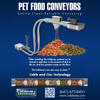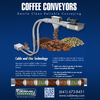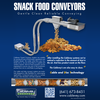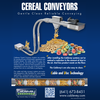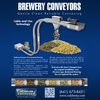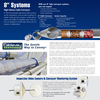Technologies & Equipment in Processing Snack Foods
Featured Product from Cablevey Conveyors

Technologies and Equipment in Processing Snack Foods
Although people usually classify snacks into two groups (sweet and salty), these dietary products may also be categorized according to the food processing technique applied in their production. Thus, we can talk about the first-generation snacks produced by simple extrusion without further processing. Snacks like popcorn, nuts, dried fruit, or potato chips fall into the first-generation snacks group.
The majority of snacks are second-generation products, meaning they are high-fiber, high-protein snack products made of extruded materials like puffed corn products, corn chips, curls, and balls. Third-generation snacks refer to fried and flavored snacks produced from extruded pellets, such as breakfast cereal. Snack pellets are non-expanded and made from raw materials like potatoes, cereals, and vegetable powder. Snack food manufacturers further process these semi-finished products to create ready-to-eat snacks.
Snack food market leaders focus on efficiency in the supply chain, production, distribution, product development, market research, and advertising. These actions are necessary for achieving success and meeting the demands of an ever-changing market. This article will present several basic processes that lead to ready-to-go, convenient, and tasty snack products that will be easily accessible and affordable. It will also focus on emerging snack food processing and packaging technology that fits the new wellness-oriented food trends.
Technologies Used in Snack Food Processing
Before any of these technologies are employed the product needs to be designed and tested. This involves much forethought and planning. Once the product proves successful the exact blend of materials has to be maintained from day one. Consistency is key.
- Extrusion
This process happens in an extrusion cooker – a high-temperature, short-time, plug-flow bioreactor that combines various operations into one unit. The extrusion process involves:
- Continuous mixing of raw materials, like various grains with water
- Shearing or kneading
- Heating and cooking using the heat released in the extruder
- Puffing is the last stage in creating puffed snacks, and this is a sudden expansion of plasticized and gelatinized starch from a pressure chamber
Compared to all other categories, the extruded snack category has the greatest potential for growth. Extruded snacks can be made in innovative ways that capture the consumer’s imagination. The perfect examples of extruded snacks are three-dimensional snacks – alphabet, cartoon, animal shapes, etc. Manufacturing a successful extruded snack is a fine balance between the manufacturer’s production abilities, quality control and economics, and consumer needs (like interests and tastes). What plays an important role in the product’s selling price is raw material costs, so it’s an advantage to use low-cost materials to manufacture a successful snack.
- Co-Extrusion
Co-extrusion is a relatively new technology that was introduced in 1984 for this industry. In the co-extrusion process, two different materials get extruded from a single die, and they can come from one extruder and one pump or from two extruders. Using this process, snack food manufacturers can create a snack with two different textures, colors, or flavors. The most common snack food produced by this process is a cereal-based outer tube with a cheese filling.
On the market, you can find three types of co-extruded snack foods: cereal based tubes with a water-based filling, cereal-based tubes with a fat-based filling, and cereal-based tubes with a cereal-based filling. Due to the migration of oil and/or moisture from the filling to the outer shell, these snacks have a limited shelf life.
- Expansion
This snack category is also called second-generation snacks or collet, and most extruded snack foods are in this category. Expanded snacks are low-calorie, high-protein, and high-fiber snack foods that are made on high-shear extruders. Some examples are potato sticks, onion rings, corn curls, and three-dimensional snacks. They can also be seasoned with various flavors, sugars, salt, oil, etc. The quality of expansion-manufactured snack foods depends on the raw material used in the formulation and the conditions of operation of the extruder. There are other factors that can affect the degree of puffing of snacks during the process, such as cereal particle size, dough residence time in the extruder barrel, and amount of moisture in the feed material.
- Frying
The most familiar extruded snacks in today’s snack market are fried collets which get their specific twisted puffed shape thanks to a special die arrangement. Fried collets are produced on collet extruders, then fried in vegetable oil and coated with a flavor. During the frying process, the level of moisture reduces from 8% to 2%. Snack producers may use continuous fryers for large-scale production (over 5000 lb/hour throughput), while batch fryers are convenient for the small-scale snack producers (less than 200 lb/hr). The material most commonly used for producing fried collet is corn meal.
- Baking
Another example of the extruded expanded snack foods are baked collets (e.g., potato sticks, onion rings, and baked corn curls). They can be made with different tuber flours and cereal grains. Bran, cellulose, fibers, and protein can be blended with cereal grain (making up to 20% of the material) to make healthy snack foods. As for potato sticks, they are usually made by mixing potato flour with rice or corn flour. The baking process involves cooking snacks with heat transferred through the air by convection, conduction, or radiation. The effectiveness of each of these methods depends on the oven type and product design.
- Drying
Certain products, like puffed snacks, become crispy through the drying process. These snacks need to be dried after the extrusion process, until the moisture level drops under 4%. This way, puffed snacks gain satisfactory texture and storage stability. Drying process control plays a significant role in ensuring that moisture does not go above or below the determined level.
Miscellaneous Equipment and Snack Food Technology
- Oil, granule, or powder applicators, as well as coating tumblers, electrostatic salters, powder dispensers, and cheese sprayers, are specialized equipment essential in the flavoring process. It enables snack manufacturers to create various snacks from the same base.
- Moving and storage equipment are essential for preserving raw material quality. Inadequate storage of natural materials used in snack production may seriously affect their quality. For example, dark spots may appear on potato or corn chips, as well as french fries, if the potatoes used in the production process are not stored properly.
- Measuring and weighing equipment provide data useful for process monitoring and feedback.
- Packaging should ensure that the finished product has a long shelf life. Also, process control needs to ensure that the packaged snack weight is close to the value specified on the package.
- Nut processing systems include various sorters, blanchers, roasters, and coolers.
New Process Equipment and Packaging Technologies That Meet the Market Demand
There is an increased demand for more nutritious food products, which drives the increased investment and innovation to create new products in terms of different forms, flavors, and tastes. Therefore, manufacturers of snack foods are implementing new technologies in snack production to meet these needs. According to PR Newswire, the global snack food market that was worth $210.4 billion in 2019 is projected to top out at $215.9 billion this year (at a CAGR of 2.7%).
Besides health and wellness, sustainability is also an essential trend that snack producers want to follow in 2020. Here are some modern technologies that will support snack companies in achieving these goals.
- Vacuum Frying Technology
Frying technology has improved to enhance the nutritional values of processed and packaged snacks. For example, batch frying is a technique that produces snack foods with low fat and acrylamide levels. This is a potentially carcinogenic substance that appears when starchy raw materials fry at high temperatures for a long time. During the vacuum frying process, the frying vessel is enclosed, and the water temperature is below 100 C due to the reduced pressure. This way, ingredients continually fry at low temperatures, preventing the appearance of acrylamide and the saturation of oil, resulting in a nutritious finished product.
- Flexible Packaging Machines and Systems
Snack’s packaging has shifted from share-size bags to single-portion packages. This change requires advanced packaging machines that provide flexible packaging materials, sizes, high speeds, and lower reject rates. By implementing these innovative systems, snack food companies will be able to implement better packaging materials and smaller sizes that comply with the WHO guidelines.
- Tubular Cable Drag Conveying Systems
Packaging size reduction requires additional adjustment of other parts of processing technology to ensure that the packaging line can cope with the produced amounts efficiently. For this reason, snack producers need to invest in transferring systems, like Cablevey Conveyors, to ensure gentle and sanitary moving of specific amounts through different production stages.
This advanced handling equipment offers a wide range of tubular conveyor capacities to ensure safe material handling and an enclosed, dust-free environment in different snack production stages. Small 2-inch diameter high-capacity tube conveyors are perfect for moving ingredients like cookie crumbs or various seeds. On the other hand, high-volume 8-inch diameter cable conveyors gently and safely move materials like in-shell walnuts, peanuts, or puffed rice breakfast cereals.
When the product is designed, tested, and proven successful, snack food manufacturers need to maintain the exact blend of materials from the very beginning. Recipe-makers, food designers, and engineers employ a stringent set of standards to build, design, refine and maintain specific blends and ratios of ingredients…in other words, salt, sugar, fat and flour are main components – but they don’t allow for the distinctions that make these companies products famous.
Snack food manufacturers can achieve sustainability, safe and fast material distribution throughout the processing facility, and energy savings by using modern conveyor systems such as Cablevey’s. Furthermore, our conveyors will considerably reduce product damage, while simultaneously reducing waste. This cabled tubular conveying system will ensure that crackers, corn chips, or extruded materials move safely through different production stages without breaking. This is also true for moving wrapped or unwrapped candies. These sweet snacks will not be broken, beaten, or squeezed while being moved through the various processing stages.



